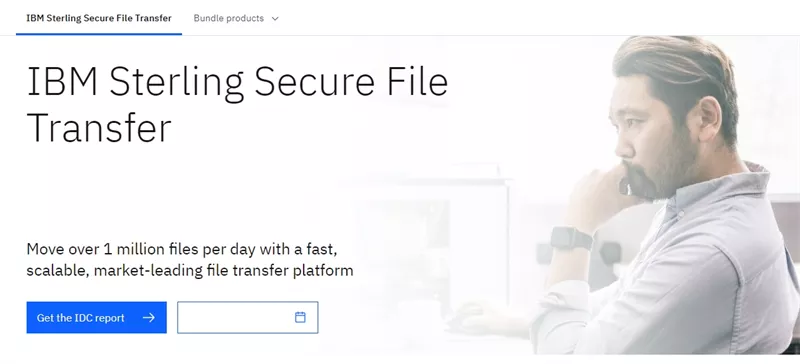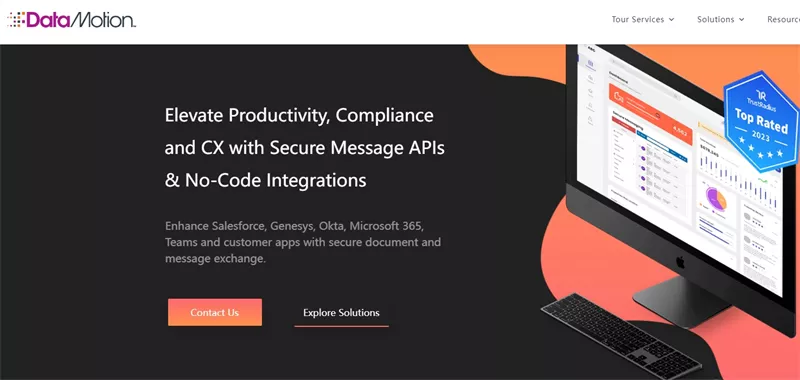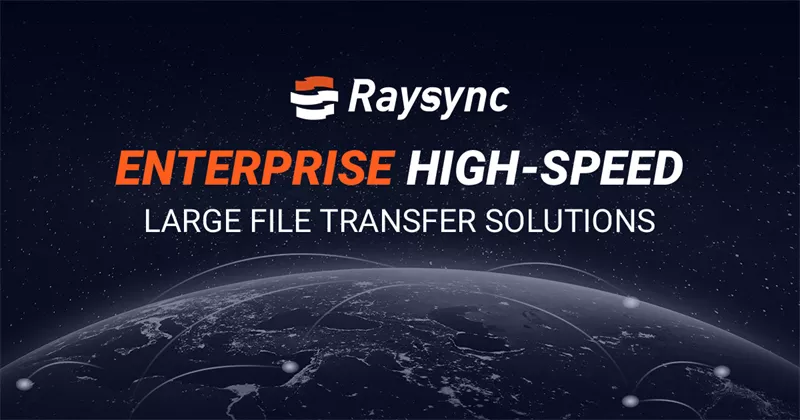Top 3 MFT Providers to Securely Sharing Data for Enterprise
In today's digital landscape, enterprises juggle massive amounts of data, often containing sensitive information. Securely sharing this data with partners, vendors, and even internally across departments is crucial.

This is where Managed File Transfer (MFT) comes in. This guide will dive into the top 3 MFT providers that cater specifically to the needs of enterprises, helping enterprises select the one that best safeguards their data-sharing practices.
Part 1: What Is MFT Provider
An MFT provider, or Managed File Transfer provider, is a company that offers software and services to securely transfer files electronically.
These providers handle the automation, encryption, and access controls for data transfers, ensuring that sensitive information is shared securely within an organization or with external parties.
Part 2: Best 3 MFT Providers to Consider
Having explored the role of MFT providers in secure data exchange, this section dives into three leading options specifically suited for enterprise needs.
Each provider offers unique strengths and functionalities, so a close examination is recommended to identify the best fit for your organization's specific requirements.
1. IBM Sterling Secure File Transfer
IBM Sterling Secure File Transfer is a managed file transfer (MFT) solution offered by IBM. An MFT solution is essentially a secure and reliable way to electronically transfer large files between different locations or users.

Pros of IBM Sterling Secure File Transfer:
- Unmatched Security: Utilizes military-grade encryption, access controls, and intrusion detection for top-notch data protection during transfers.
- Enhanced Visibility and Control: Provides a centralized dashboard to monitor all file transfer activities, identify bottlenecks, and ensure compliance with internal policies or external regulations.
- Scalability for Growth: Adapts to accommodate growing data volumes and user bases.
- Streamlined Workflows and Efficiency: Offers high-performance transfers and workflow automation capabilities.
- Trusted Brand and Support: Backed by IBM's reputation and experience, you can expect reliable support services for smooth implementation and ongoing assistance.
Cons of IBM Sterling Secure File Transfer:
- Potential Cost: Being a solution from a major brand, IBM Sterling Secure File Transfer might have a higher upfront cost compared to some competitors.
- Complexity: The comprehensive feature set might require a steeper learning curve for some users compared to simpler MFT solutions.
- Customization: Customization options might be limited compared to open-source MFT solutions.
Brand Association of IBM Sterling Secure File Transfer:
If we consider the MFT industry to be like the car industry, then IBM Sterling Secure File Transfer would be a brand known for its luxury armored vehicles.
This metaphor emphasizes the following strengths of IBM Sterling Secure File Transfer:
- Security: Like an armored vehicle, it prioritizes data protection.
- Reliability: It's a dependable solution for secure file transfer.
- Performance: It suggests a high-performing MFT solution.
Pricing Plan: You need to request a quotation in order to get a price.
2. DataMotion
DataMotion is an MFT provider that specializes in secure information transfer solutions, particularly focused on the financial services industry.

DataMotion offers a secure messaging center that integrates seamlessly with existing applications, portals, and systems. This integration creates a familiar and convenient user experience for financial advisors and their clients.
Pros of DataMotion:
- Focus on User Experience: Integrates seamlessly with existing applications, portals, and systems within the financial services industry.
- Enhanced Security: Employs military-grade encryption, zero-trust architecture, and other features to safeguard sensitive financial data during transfers.
- Improved Client Retention: By providing a secure and user-friendly communication channel, DataMotion can help financial advisors build stronger relationships with their clients and potentially increase client retention.
- Streamlined Workflows: Simplifies the process of exchanging sensitive information between advisors and clients. This can save time and improve overall workflow efficiency.
- Regulatory Compliance: Helps financial institutions adhere to data privacy regulations like LGPD (Brazil). This reduces the risk of non-compliance fines and penalties.
Cons of DataMotion:
- Limited Scope: DataMotion's solution is specifically designed for the financial services industry. It might not be suitable for businesses in other sectors with different file transfer needs.
- Potential Vendor Lock-in: Integrating DataMotion tightly with existing systems might create dependence on their platform, making it difficult or expensive to switch to a different solution in the future.
- Cost: Pricing information for DataMotion is not readily available publicly. Depending on the features and volume required, it might be a costlier option compared to some general-purpose MFT solutions.
Brand Association of DataMotion
In the context of the car industry, DataMotion's brand association would likely be a high-security, luxury sedan. Here's why this metaphor aligns well:
- Security Focus: Similar to a high-security sedan equipped with advanced security features, DataMotion prioritizes data protection.
- Targeted Clientele: Luxury sedans cater to a specific clientele who value both style and performance.
- Seamless Integration and User Experience: Just like a luxury sedan offers a smooth and comfortable ride, DataMotion integrates seamlessly with existing workflows without disrupting user habits.
- Discreet Operation: DataMotion's secure messaging platform functions behind the scenes, offering robust security without being a bulky or intrusive element in financial advisor-client communication.
Pricing Plan: You need to request a quotation in order to get a price.
3. Raysync
Raysync is a software company specializing in Managed File Transfer (MFT) solutions. As a MFT provider, they focus on providing businesses with a secure and efficient way to transfer large files.

Pros of Raysync:
- High-Speed Transfers: Raysync utilizes its UDP protocol to achieve faster file transfers compared to traditional methods like FTP.
- Security Focus: Data security is a priority for Raysync. They offer features like military-grade encryption, two-factor authentication, and data loss prevention to safeguard sensitive information during transfers.
- Scalability and Flexibility: Their MFT solution can adapt to accommodate growing data needs and integrate with various existing systems.
- User-Friendly Interface: Raysync provides a user-friendly interface that simplifies file transfer processes for both technical and non-technical users.
- Multiple Deployment Options: Raysync offers on-premise, cloud-based, and hybrid deployment options to cater to different business needs.
- Cost-Effective: Compared to some enterprise-grade MFT solutions, Raysync might be a more cost-effective option, especially for smaller businesses or those with specific needs.
Cons of Raysync:
- Limited Customization: While Raysync offers a comprehensive set of features, customization options might be limited compared to open-source MFT solutions.
- Brand Recognition: Compared to established enterprise MFT providers, Raysync might have lower brand recognition. This could be a concern for some businesses prioritizing solutions from larger, more well-known vendors.
Brand Association of Raysync
Using the same metaphor, A high-performance electric car perfectly captures Raysync's key strengths in the MFT industry:
- Speed and Efficiency: Just like electric cars excel in these areas, Raysync utilizes its UDP protocol to achieve rapid and reliable file transfers.
- Eco-Friendly Considerations: While not directly related to data transfer, some electric car brands prioritize environmentally friendly practices, which aligns with Raysync's cost-effective solutions that potentially reduce reliance on physical media for data transfer.
- Modern Technology Appeal: Electric cars represent a forward-thinking approach to transportation, similar to how Raysync positions itself as a modern and innovative solution in the MFT industry.
Raysync provides various Pricing Plans:
- 99$/Month for Raysync Cloud
- 699$/Annual for Raysync SMB (Small & Medium Business)
- Request A Quotation for Raysync Enterprise
Part 3: How to Choose A Suitable MFT Provider for Enterprise
Selecting the ideal Managed File Transfer (MFT) provider for your enterprise requires careful consideration. This part will outline key factors to evaluate when choosing an MFT solution to ensure it aligns with the enterprise’s specific business needs and budget.
Step 1: Identify Your Needs
- Data Sensitivity: Evaluate the type of data you will be transferring. Is it highly confidential or subject to specific regulations? This will influence the security features you need in an MFT solution.
- Data Volume and Frequency: Consider the typical size and frequency of your file transfers. High-volume transfers or large files might necessitate an MFT solution optimized for speed and scalability.
- Workflow Integration: Assess how the MFT solution will integrate with your existing workflows and systems. Seamless integration minimizes disruption and simplifies overall file transfer processes.
- User Base and Expertise: Consider the technical skillset of your users. A user-friendly interface is crucial for wider adoption and efficient use of the MFT solution.
- Budget: Determine your budget for the MFT solution, including both upfront costs and ongoing maintenance fees.
Step 2: Evaluate MFT Providers
- Security Features: Compare the security protocols offered by different providers, such as encryption standards, access controls, and intrusion detection capabilities. Ensure they meet your data security requirements.
- Scalability and Flexibility: Choose an MFT solution that can adapt to your growing data volume and user base. Consider integration capabilities with various systems for future-proofing your file transfer needs.
- User Interface and Usability: Evaluate the user interface of the MFT solution for ease of use by both technical and non-technical users. A user-friendly interface promotes faster adoption and streamlines file transfer workflows.
- Deployment Options: Consider your preferred deployment model - on-premise, cloud-based, or hybrid. Choose an MFT provider that offers the deployment option that best aligns with your security requirements and IT infrastructure.
- Customer Support: Evaluate the level of customer support offered by different providers. This includes factors like availability, response times, and the range of support services offered.
Step 3: Research and Compare
- Read online reviews and analyst reports.
- Request demos and trials from shortlisted vendors.
- Compare pricing structures and total cost of ownership.
Part 4: FAQs about MFT Providers
Managed File Transfer (MFT) solutions play a crucial role in securing and streamlining data exchange within organizations. This FAQ section aims to clarify common questions regarding MFT providers and their offerings, helping you make informed decisions for your business.
Q1: What is MFT services
MFT services, or Managed File Transfer services, provide a secure and efficient way to electronically transfer large files between different locations or users. Here's a breakdown of the key terms:
- Managed: MFT software acts as a centralized platform to manage and oversee all file transfer activities within an organization. This includes features like user permissions, scheduling, and monitoring transfer progress.
- File Transfer: MFT solutions specialize in transferring large files, which can be slow and error-prone using traditional methods like FTP (File Transfer Protocol).
- Secure: Security is paramount in MFT solutions. They employ encryption and other measures to safeguard sensitive data during transfers.
Q2: What is MFT used for
MFT (Managed File Transfer) is used for a variety of purposes by businesses that need to securely and efficiently transfer large files. Here are some common applications:
- Sharing Large Files Internally
- Exchanging Data with Partners (B2B)
- Complying with Regulations
- Automating File Transfers
- Centralized Management
Overall, MFT is a valuable tool for businesses of all sizes that need to securely, reliably, and efficiently transfer large files.
Q3: What is the most secure file-sharing service
Actually, there isn't a single "most secure" way for file sharing, as the best approach depends on your specific needs and the type of data you're transferring. Here are some factors to consider:
For highly confidential information, prioritize services with robust encryption (AES-256) and zero-knowledge architecture, where the provider cannot access your decryption key.
Here are some MFT services that utilize AES-256 encryption:
- Raysync: While their marketing materials might not explicitly mention AES-256, they emphasize military-grade encryption, which typically refers to AES-256 or a similar high-grade standard. It's always best to confirm directly with Raysync for their specific encryption algorithm.
- IBM Sterling Secure File Transfer: This industry leader offers military-grade encryption, including AES-256, to safeguard sensitive data during transfers.
- JSCAPE MFT Server: This MFT solution utilizes AES-256 encryption on data both at rest and in transit, ensuring comprehensive data protection.
- Axway Managed File Transfer: They leverage AES-256 encryption alongside other security measures like access controls and intrusion detection to provide a robust security posture.
- Kiteworks by Accellion: This cloud-based MFT service employs AES-256 encryption for data at rest and in transit, along with additional features like data loss prevention.
For less sensitive data, there are some secure cloud storage service with strong encryption might suffice:
- Dropbox Vault (paid add-on to Dropbox that offers stronger encryption and security features).
- pCloud Crypto (paid add-on to pCloud that provides client-side encryption with a zero-knowledge approach).
- MEGA (offers large free storage plans with strong encryption, but privacy laws in their jurisdiction raise some concerns for some users).
Final Words
In the end, we all know that secure data sharing is crucial for enterprises. By considering your needs and evaluating MFT providers based on security, scalability, and ease of use, you can choose the solution that best safeguards your sensitive information during transfers.
You might also like

Raysync News
January 31, 20235 Latest Ways to Protect Your Private Data 2024
Data is an advanced commodity, which makes it extremely important to manage data. Without proper tools and strategies, your data may not be as secure as you think.

Raysync News
September 28, 2021Top 8 Large File Transfer Problmes
Finally, to curb these problems, the Raysync solution was created. Rasysync can help enterprises to efficiently send and easily manage large files.

Raysync News
January 28, 2021Transfer 10GB Large Files in Urgent with Raysync Transfer Protocol
Based on UDP, Raysync ultra-high-speed transmission protocol breaks through the technical barriers of traditional transmission protocols, and the transmission speed is increased to 100 times that of FTP.